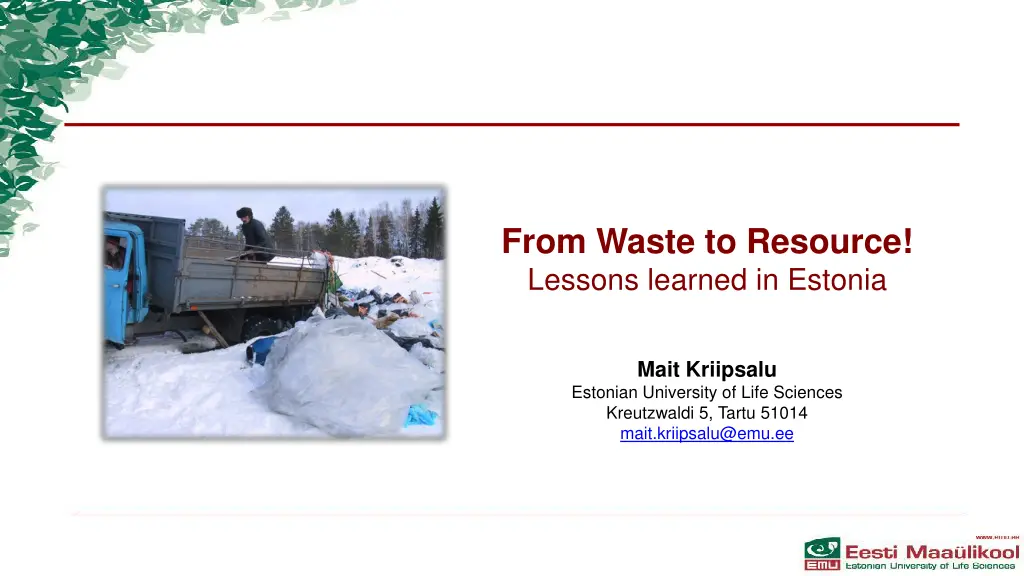
Lessons Learned in Estonia: From Waste to Resource
Discover the transformation of waste management in Estonia from primitive practices lacking infrastructure and laws in the early 1990s to a structured system with improved collection, disposal, and recycling methods. Learn about the significant progress made in landfill management and the shift towards a more sustainable approach to waste handling.
Download Presentation

Please find below an Image/Link to download the presentation.
The content on the website is provided AS IS for your information and personal use only. It may not be sold, licensed, or shared on other websites without obtaining consent from the author. If you encounter any issues during the download, it is possible that the publisher has removed the file from their server.
You are allowed to download the files provided on this website for personal or commercial use, subject to the condition that they are used lawfully. All files are the property of their respective owners.
The content on the website is provided AS IS for your information and personal use only. It may not be sold, licensed, or shared on other websites without obtaining consent from the author.
E N D
Presentation Transcript
From Waste to Resource! Lessons learned in Estonia Mait Kriipsalu Estonian University of Life Sciences Kreutzwaldi 5, Tartu 51014 mait.kriipsalu@emu.ee
How did we start: Early 1990-s Until 1990-ies, waste management was primitive No law, no good planning Law-making started in 1992 No infrastructure No owner No understanding of economics Poor education and poor professional performance Poor applied on people, municipalities, and companies
What did we get from PAST First things to do: inventory and reporting Inventory of dumpsites, waste arisings, hazardous sites Waste management was dumpsite-based Many dumps, never built in-purpose. Badly placed and maintained Broken containers and ugly trucks. Cheap! No public recycling stations, no hazwaste collection No biological treatment, no incineration but some recycling.
First decisions We wanted to have a clean country (waste=pollution)! Motivator was EU All private, but not landfills! Everyone had to pay (no free waste collection)! Planning and law-making! Hazwaste collection had priority Pollution charge applied on landfilled waste.
Disposal to landfill must not be cheap! Pollution charge rates for waste disposal (Euro) 30 10-15-20 0,03 1992 If a landfill did not comply penalty x 3 Larger quantities than permitted penalty x 5 Toxic waste (organic pesticides) 520 /t penalty x 200
Progress Owner was named for every landfill Collection and transportation was improved (visual!) No hazwaste was hidden in municipal landfills Paperwork and statistics well done Authorities were trained a lot (by EU & Nordic) Know-how from Nordic countries (finances, planning) Base for investments was created Waste hierarchy & EU Landfill Directive
and in 2013 Landfills in 1999 In 1999 351 municipal dumps Massive closure process until 2009 In 2019 5 Eurolandfills, no old dumps
Packaging waste Implementation of Packaging directives Deposit on bottles (plastic, glass, metal 0.1 ) Reverse vending machines in every shop Over 200 bottles are returned per person per year!
Why this development was possible? Knowledge has increased! Education! Law in place Polluter pays, producer is responsible Price for raw materials increases Market for waste products (SRF, aggregates, materials) Investments, EU + local + private Overcapacity Good project management (individual person counts!)
Waste Management today Separate collection Mixed packages, paper, glass, EPR stuff (WEEE, tyres) Energy Mass-burn in Tallinn, Solid Recovered Fuel for Cement industry End-of-waste criteria! Is it waste, product or material? Biotreatment will be the largest challenge in coming years. Expecting bans (very thin carrier bags, plastic cups, etc)
EU 2020 50:50 EU 2035 65:35 Less disposal Positive Negative More biotreatment! Some biotreatment! Less incineration Package recycling A lot of incineration!
Thank you! Mait Kriipsalu mait.kriipsalu@emu.ee
